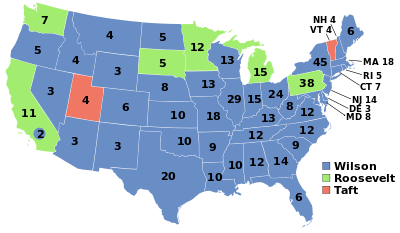Like Lincoln, Wilson faced a divided opposition, with liberal Republicans favoring Roosevelt and conservative Republicans solid on President Taft. Like Lincoln, he got well under a majority of the vote, although he nearly made it to 42%. Unlike Lincoln, his divided opposition wasn't particularly regional, and while he was particularly strong in the South, he wasn't too weak anywhere.
Once again, the easiest way to make Wilson lose is to tip the contest into the House; since Wilson got 435 electoral votes, it's going to take some work to get down to 265. After we pick off the low-hanging fruit, we'll start making broader assumptions to cut his total more.
Idaho -- Wilson 33,921; Taft 32,810. 435 to 431.
Illinois -- Wilson 405,048; Roosevelt 386,478. 431 to 402.
North Dakota -- Wilson 29,555; Roosevelt 25,726. 402 to 397.
Massachusetts -- Wilson 173,408; Taft 155,948. 397 to 379.
Wyoming -- Wilson 15,310; Taft 14,560. 379 to 376.
Iowa -- Wilson 185,325; Roosevelt 161,819. 376 to 363.
Rhode Island -- Wilson 30,412; Taft 27,703. 363 to 358.
Connecticut -- Wilson 74,561; Taft 68,328. 358 to 351.
Maine -- Wilson 51,113; Roosevelt 48,495. 351 to 345.
New Hampshire -- Wilson 34,724; Taft 32,927. 345 to 341.
That's about all we can do easily. Now, what if Taft had stuck to his base of the northeast and Roosevelt provoked Wilson into displaying his southern roots more openly? Larger shifts in New Jersey and the Mid and Mountain West become more plausible.
Oregon -- Wilson 47,064; Roosevelt 37,600. 341 to 336.
Montana -- Wilson 27,941; Roosevelt 22,456. 336 to 332.
Kansas -- Wilson 143,663; Roosevelt 120,210. 332 to 322.
New Jersey -- Wilson 178,289; Roosevelt 145,410. 322 to 308.
New Mexico -- Wilson 20,437; Taft 17,733. 308 to 305.
New York -- Wilson 655,573; Roosevelt 390,093; Taft 455,487. 305 to 260.
There we go. Wilson drops all the way to 260, Roosevelt is at 168 (or 213), Taft is at 97 (or 52). The election goes to the House, which has a Democratic majority elected in 1910. Unfortunately for Wilson, a lot of that majority is in unanimous Southern delegations, which still only give one vote each, while Illinois' 14 Republicans overrule the 11 Democrats. Republican majorities: CA, CT, DE, ID, IL, IA, KS, MA, MI, MN, MT, NV, NH, ND, OR, PA, SD, UT, VT, WA, WI, WY: 22 states. Maine, New Mexico, and Rhode Island were evenly split, and the other 23 were Democratic. Nobody's got a majority of the delegations, so nobody can win on the first ballot.
It is difficult to say who could have turned this into a victory -- Wilson can depend on the loyalty of the Democratic delegations, for the most part, but Roosevelt and Taft would have warred bitterly. It's certainly possible, though, that Roosevelt's men could have won Taft-loyal Republicans over with promises of the president's ear, along with ample amounts of patronage; in the actual election, Taft knew he was going to lose, so he likely would not have had as much will to try to come back from a distant third place in the House.

No comments:
Post a Comment